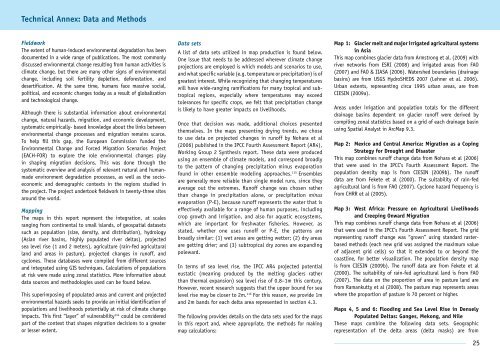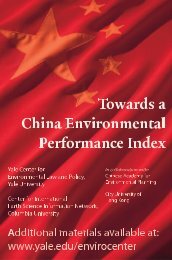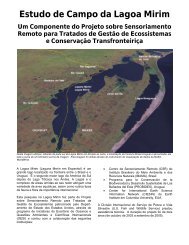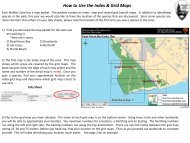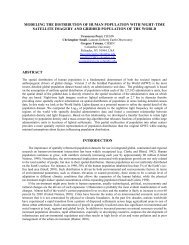In Search of Shelter - Center for International Earth Science ...
In Search of Shelter - Center for International Earth Science ...
In Search of Shelter - Center for International Earth Science ...
You also want an ePaper? Increase the reach of your titles
YUMPU automatically turns print PDFs into web optimized ePapers that Google loves.
Technical Annex: Data and MethodsFieldworkThe extent <strong>of</strong> human-induced environmental degradation has beendocumented in a wide range <strong>of</strong> publications. The most commonlydiscussed environmental change resulting from human activities isclimate change, but there are many other signs <strong>of</strong> environmentalchange, including soil fertility depletion, de<strong>for</strong>estation, anddesertification. At the same time, humans face massive social,political, and economic changes today as a result <strong>of</strong> globalizationand technological change.Although there is substantial in<strong>for</strong>mation about environmentalchange, natural hazards, migration, and economic development,systematic empirically- based knowledge about the links betweenenvironmental change processes and migration remains scarce.To help fill this gap, the European Commission funded theEnvironmental Change and Forced Migration Scenarios Project(EACH-FOR) to explore the role environmental changes playin shaping migration decisions. This was done through thesystematic overview and analysis <strong>of</strong> relevant natural and humanmadeenvironment degradation processes, as well as the socioeconomicand demographic contexts in the regions studied inthe project. The project undertook fieldwork in twenty-three sitesaround the world.MappingThe maps in this report represent the integration, at scalesranging from continental to small islands, <strong>of</strong> geospatial datasetssuch as population (size, density, and distribution), hydrology(Asian river basins, highly populated river deltas), projectedsea level rise (1 and 2 meters), agriculture (rain-fed agriculturalland and areas in pasture), projected changes in run<strong>of</strong>f, andcyclones. These databases were compiled from different sourcesand integrated using GIS techniques. Calculations <strong>of</strong> populationsat risk were made using zonal statistics. More in<strong>for</strong>mation aboutdata sources and methodologies used can be found below.This superimposing <strong>of</strong> populated areas and current and projectedenvironmental hazards seeks to provide an initial identification <strong>of</strong>populations and livelihoods potentially at risk <strong>of</strong> climate changeimpacts. This first “layer” <strong>of</strong> vulnerability 114 could be consideredpart <strong>of</strong> the context that shapes migration decisions to a greateror lesser extent.Data setsA list <strong>of</strong> data sets utilized in map production is found below.One issue that needs to be addressed wherever climate changeprojections are employed is which models and scenarios to use,and what specific variable (e.g. temperature or precipitation) is <strong>of</strong>greatest interest. While recognizing that changing temperatureswill have wide-ranging ramifications <strong>for</strong> many tropical and subtropicalregions, especially where temperatures may exceedtolerances <strong>for</strong> specific crops, we felt that precipitation changeis likely to have greater impacts on livelihoods.Once that decision was made, additional choices presentedthemselves. <strong>In</strong> the maps presenting drying trends, we choseto use data on projected changes in run<strong>of</strong>f by Nohara et al(2006) published in the IPCC Fourth Assessment Report (AR4),Working Group 2 Synthesis report. These data were producedusing an ensemble <strong>of</strong> climate models, and correspond broadlyto the pattern <strong>of</strong> changing precipitation minus evaporationfound in other ensemble modeling approaches. 115 Ensemblesare generally more reliable than single model runs, since theyaverage out the extremes. Run<strong>of</strong>f change was chosen ratherthan change in precipitation alone, or precipitation minusevaporation (P-E), because run<strong>of</strong>f represents the water that iseffectively available <strong>for</strong> a range <strong>of</strong> human purposes, includingcrop growth and irrigation, and also <strong>for</strong> aquatic ecosystems,which are important <strong>for</strong> freshwater fisheries. However, asstated, whether one uses run<strong>of</strong>f or P-E, the patterns arebroadly similar: (1) wet areas are getting wetter; (2) dry areasare getting drier; and (3) subtropical dry zones are expandingpoleward.<strong>In</strong> terms <strong>of</strong> sea level rise, the IPCC AR4 projected potentialeustatic (meaning produced by the melting glaciers ratherthan thermal expansion) sea level rise <strong>of</strong> 0.8–1m this century.However, recent research suggests that the upper bound <strong>for</strong> sealevel rise may be closer to 2m. 116 For this reason, we provide 1mand 2m bands <strong>for</strong> each delta area represented in section 4.3.The following provides details on the data sets used <strong>for</strong> the mapsin this report and, where appropriate, the methods <strong>for</strong> makingmap calculations:Map 1: Glacier melt and major irrigated agricultural systemsin AsiaThis map combines glacier data from Armstrong et al. (2009) withriver networks from ESRI (2008) and irrigated areas from FAO(2007) and FAO & IIASA (2006). Watershed boundaries (drainagebasins) are from USGS HydroSHEDS 2007 (Lehner et al. 2006).Urban extents, representing circa 1995 urban areas, are fromCIESIN (2009a).Areas under irrigation and population totals <strong>for</strong> the differentdrainage basins dependent on glacier run<strong>of</strong>f were derived bycompiling zonal statistics based on a grid <strong>of</strong> each drainage basinusing Spatial Analyst in ArcMap 9.3.Map 2: Mexico and Central America: Migration as a CopingStrategy <strong>for</strong> Drought and DisasterThis map combines run<strong>of</strong>f change data from Nohara et al (2006)that were used in the IPCC’s Fourth Assessment Report. Thepopulation density map is from CIESIN (2009b). The run<strong>of</strong>fdata are from Fekete et al (2000). The suitability <strong>of</strong> rain-fedagricultural land is from FAO (2007). Cyclone hazard frequency isfrom CHRR et al (2005).Map 3: West Africa: Pressure on Agricultural Livelihoodsand Creeping Onward MigrationThis map combines run<strong>of</strong>f change data from Nohara et al (2006)that were used in the IPCC’s Fourth Assessment Report. The gridrepresenting run<strong>of</strong>f change was “grown” using standard rasterbasedmethods (each new grid was assigned the maximum value<strong>of</strong> adjacent grid cells) so that it extended to or beyond thecoastline, <strong>for</strong> better visualization. The population density mapis from CIESIN (2009b). The run<strong>of</strong>f data are from Fekete et al(2000). The suitability <strong>of</strong> rain-fed agricultural land is from FAO(2007). The data on the proportion <strong>of</strong> area in pasture land arefrom Ramankutty et al (2008). The pasture map represents areaswhere the proportion <strong>of</strong> pasture is 70 percent or higher.Maps 4, 5 and 6: Flooding and Sea Level Rise in DenselyPopulated Deltas: Ganges, Mekong, and NileThese maps combine the following data sets. Geographicrepresentation <strong>of</strong> the delta areas (delta masks) are from25


